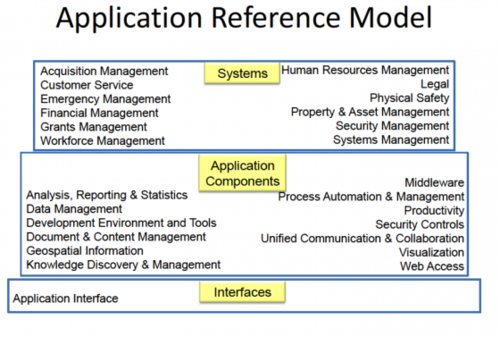Difference between revisions of "Application-Capability Reference Model (ARM)"
m (The LinkTitles extension automatically added links to existing pages (https://github.com/bovender/LinkTitles).) |
m |
||
| Line 1: | Line 1: | ||
| − | The | + | The Application-Capability Reference Model or Application Reference Model (ARM) is a business-driven, functional framework that supports Federal agencies. It classifies application capabilities with respect to how they support business and/or performance objectives. The ARM is envisioned being structured across horizontal service areas that, independent of the business functions, can provide a leveragable foundation for reuse of applications, application capabilities, components, and business service. The model aids in recommending applications to support the reuse of business components and services across the Federal Government. <ref>Definition of Application-Capability Reference Model (ARM)[http://xml.coverpages.org/FEA-BusinessModelv10.pdf FEAPMO]</ref> |
| − | The Application Reference Model (ARM) supports architectural analysis and reporting in the applications sub- | + | The Application Reference Model (ARM) supports architectural analysis and reporting in the applications sub-architecture view of the overall EA. The ARM is a component-driven taxonomy that categorizes the system and application related standards and technologies that support and enable the delivery of service components and capabilities. It also unifies existing agency application portfolios and guidance on standard desktop configurations by providing a foundation to advance the reuse and standardization of technology and service components from a Federal Government perspective. Aligning agency capital investments to the ARM leverages a common, standardized vocabulary, allowing inter-agency discovery, collaboration, and interoperability. Agencies and the Federal Government will benefit from economies of scale by identifying and reusing the best solutions and technologies for applications that are developed/provided or subscribed to support their business functions, mission, and target architecture.<ref>What is Application-Capability Reference Model (ARM)? [https://eapad.dk/gov/us/common-approach/reference-models/ EA Pad]</ref> |
| Line 9: | Line 9: | ||
===See Also=== | ===See Also=== | ||
| − | + | ||
| − | |||
| − | |||
| − | |||
| − | |||
| − | |||
| − | |||
| − | |||
| − | |||
| − | |||
| − | |||
| − | |||
| − | |||
| − | |||
| − | |||
| − | |||
| − | |||
| − | |||
| − | |||
| − | |||
| − | |||
| − | |||
| − | |||
| − | |||
| − | |||
| − | |||
| − | |||
| − | |||
| − | |||
| − | |||
| Line 46: | Line 17: | ||
===Further Reading=== | ===Further Reading=== | ||
| − | *Introduction to the Architectural Reference Model for the | + | *Introduction to the Architectural Reference Model for the Internet of Things [http://iotforum.org/wp-content/uploads/2014/09/120613-IoT-A-ARM-Book-Introduction-v7.pdf iotforum.org] |
*Application Reference Model - UK Government [[Reference Architecture]] [https://lenand.files.wordpress.com/2012/01/ukra1-0-lpa.doc Steve Walters, Paul Turton] | *Application Reference Model - UK Government [[Reference Architecture]] [https://lenand.files.wordpress.com/2012/01/ukra1-0-lpa.doc Steve Walters, Paul Turton] | ||
*Australian Government Architecture Reference Models [https://ofti.org/wp-content/uploads/2012/07/aga_rm_v3_0.pdf ofti.org] | *Australian Government Architecture Reference Models [https://ofti.org/wp-content/uploads/2012/07/aga_rm_v3_0.pdf ofti.org] | ||
Revision as of 10:58, 17 January 2023
The Application-Capability Reference Model or Application Reference Model (ARM) is a business-driven, functional framework that supports Federal agencies. It classifies application capabilities with respect to how they support business and/or performance objectives. The ARM is envisioned being structured across horizontal service areas that, independent of the business functions, can provide a leveragable foundation for reuse of applications, application capabilities, components, and business service. The model aids in recommending applications to support the reuse of business components and services across the Federal Government. [1]
The Application Reference Model (ARM) supports architectural analysis and reporting in the applications sub-architecture view of the overall EA. The ARM is a component-driven taxonomy that categorizes the system and application related standards and technologies that support and enable the delivery of service components and capabilities. It also unifies existing agency application portfolios and guidance on standard desktop configurations by providing a foundation to advance the reuse and standardization of technology and service components from a Federal Government perspective. Aligning agency capital investments to the ARM leverages a common, standardized vocabulary, allowing inter-agency discovery, collaboration, and interoperability. Agencies and the Federal Government will benefit from economies of scale by identifying and reusing the best solutions and technologies for applications that are developed/provided or subscribed to support their business functions, mission, and target architecture.[2]

source: The EA Pad
See Also
References
Further Reading
- Introduction to the Architectural Reference Model for the Internet of Things iotforum.org
- Application Reference Model - UK Government Reference Architecture Steve Walters, Paul Turton
- Australian Government Architecture Reference Models ofti.org
